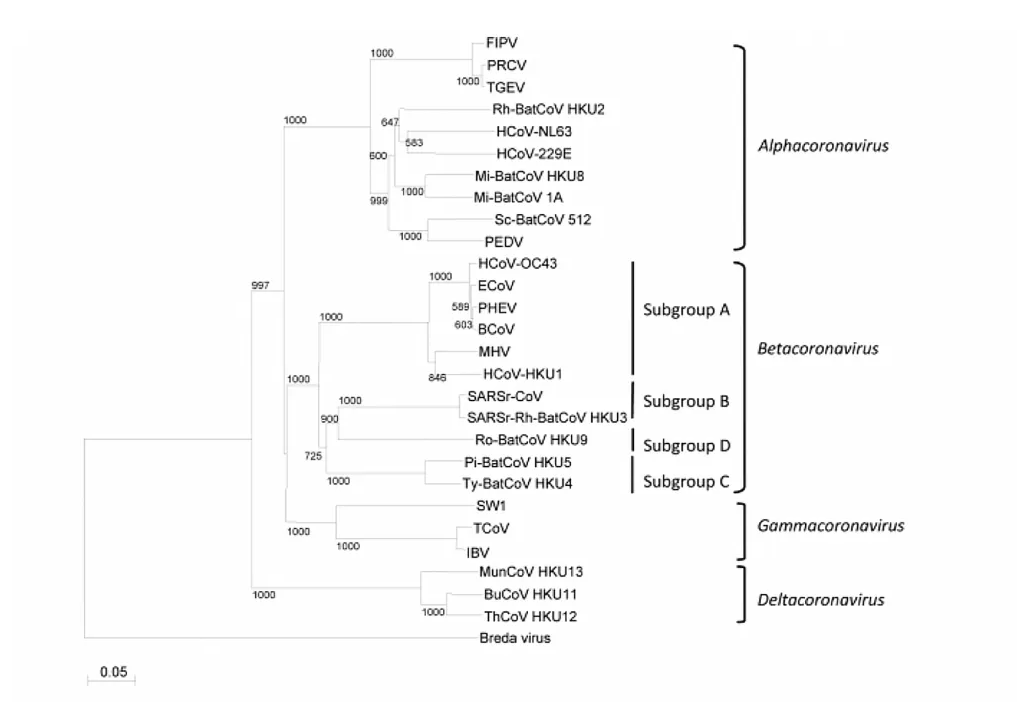
Here we present background information on coronaviruses as well as a timeline of the discovery and important developments related to coronaviruses.
What are coronaviruses?
Coronaviruses are RNA viruses that have characteristic club-shaped spikes projecting from their surface. Viewed through an electron microscope, they are said to be reminiscent of the solar corona from which they get their name.
There are 4 distinct genera of coronavirus:
alphacoronavirus, betacoronavirus, gammacoronavirus and deltacoronavirus.
Within the betacoronaviruses, which includes SARS-CoV-2, there are four subgroups, A-D.
Coronavirus family tree

There are six known species of human coronaviruses, one of which is subdivided into two different strains, making seven different human coronaviruses. Four of these cause generally mild symptoms of the common cold: HCoV-229E, -NL63, -OC43 and -HKU1 continually circulate in the human population causing respiratory infections worldwide.
- Human coronavirus OC43 (HCoV-OC43) of the genus β-CoV
- Human coronavirus HKU1 (HCoV-HKU1), β-CoV,
- Human coronavirus 229E (HCoV-229E), α-CoV
- Human coronavirus NL63 (HCoV-NL63), α-CoV
Three strains (two species) produce symptoms that can be severe; all three of these are β-CoV strains:
- Middle East respiratory syndrome-related coronavirus (MERS-CoV)
- Severe acute respiratory syndrome coronavirus (SARS-CoV)
- Severe acute respiratory syndrome coronavirus 2 (SARS-CoV-2)
The coronaviruses that cause disease in chickens, such as avian infectious bronchitis virus (IBV – a gammacoronavirus), and pigs, such as porcine respiratory coronavirus (PRCV – an alphacoronavirus) belong to different genera than the coronaviruses that cause potentially severe disease in humans: MERS-CoV, SARS-CoV and SARS-CoV-2 are all betacoronaviruses (see coronavirus family tree).
Because the avian coronaviruses and COVID-19 belong to two different groups of coronaviruses, it is highly unlikely that avian coronaviruses will infect humans, or vice-versa.
Coronavirus: key events timeline
Infectious bronchitis of chickens first described as a respiratory disease of chickens
1931

Source:
Jane K. A. Cook, M. Jackwood & R. C. Jones (2012) The long view: 40 years of infectious bronchitis research, Avian Pathology, 41:3, 239-250
Viral cause of infectious bronchitis established
1936
Source:
Jane K. A. Cook, M. Jackwood & R. C. Jones (2012) The long view: 40 years of infectious bronchitis research, Avian Pathology, 41:3, 239-250
First coronavirus (HCoV-229E) isolated from humans – initially named B814
1965

Source:
Tyrell, D.A.J. & Bynoe, M.L. (1966) Cultivation of viruses from a high proportion of patients with colds. The Lancet, 287 (7428), 76-77
Almeida and Tyrrell performed electron microscopy on B814 and found particles that resembled the infectious bronchitis virus (IBV) of chickens, widely spaced club-shaped surface projections
1967
Source:
Almeida JD & Tyrrell DA. (1967) The morphology of three previously uncharacterized human respiratory viruses that grow in organ culture. J Gen Virol. 1967 Apr;1(2):175-8.
Tyrrell led virologists working with the human strains and a number of animal viruses: infectious bronchitis virus, mouse hepatitis virus and transmissible gastroenteritis virus of swine. All were demonstrated to be morphologically using electron microscopy
Late 1960s
Source:
McIntosh K, Becker WB, Chanock RM (1967) Growth in suckling-mouse brain of “IBV-like” viruses from patients with upper respiratory tract disease. Proc Natl Acad Sci U S A. 1967 Dec;58(6):2268-73.
Officially accepted as a new genus of viruses, this new group of viruses was named coronavirus -corona referring to the crown-like appearance of the surface projections
1975

Source:
Tyrrell, D.A.J. et al. (1975) Coronaviridae. Intervirology, 5: 76-82
Genome of a coronavirus (IBV) is shown to be a positive single stranded RNA
1977
Source:
Lomniczi, B., & Kennedy, I. (1977). Genome of infectious bronchitis virus. Journal of virology, 24(1), 99–107.
Structure of IBV spike protein determined comprising two glycopolypeptides, S1 and S2
- 1983
Source:
Cavanagh, D. (1983) Coronavirus IBV: Structural Characterization of the Spike Protein. Journal of General Virology, 64, 2577-2583.
First full genome sequence of a coronavirus (IBV) published
- 1987
Source:
Boursnell et al. (1987) Completion of the Sequence of the Genome of the Coronavirus Avian Infections Bronchitis. Journal of General Virology, 68, 57-77.
Severe acute respiratory syndrome coronavirus (SARS-CoV) emerged in humans. Most probably originated in bats, was transmitted to palm civets and then to people in wet markets in southern China
- November 2002

Source:
Bart L. Haagmans, Albert D.M.E. Osterhaus, in Vaccines for Biodefense and Emerging and Neglected Diseases, 2009
https://www.sciencedirect.com/topics/medicine-and-dentistry/sars-coronavirus
SARS-CoV outbreaks occurred in Hong Kong, Hanoi, Toronto, and Singapore. All could be directly traced back to index patient who acquired the infection in Guangdong and travelled to Hong Kong. 8096 people became ill, and 774 people died in this first SARS epidemic
- 2003
Source:
Bart L. Haagmans, Albert D.M.E. Osterhaus, in Vaccines for Biodefense and Emerging and Neglected Diseases, 2009
https://www.sciencedirect.com/topics/medicine-and-dentistry/sars-coronavirus
In addition to significant morbidity and mortality, the SARS pandemic resulted in economic costs of an estimated USD 100 billion USD
- 2003
Source:
Al-Tawfiq, J.A., Zumla, A., Memish, Z.A., 2014. Travel implications of emerging coronaviruses: SARS and MERS-CoV. Travel Med. Infect. Dis. 12 (5), 422–428.
Dozens of new coronaviruses isolated from bats
- 2005 onwards
Source:
Korsmann, S.N.J. (2012) Virology. Churchill Livingstone.
First known case of MERS identified in Jordan by retrospective investigations
- April 2012

Middle East Respiratory Syndrome (MERS) is caused by a coronavirus called Middle East Respiratory Syndrome Coronavirus (MERS-CoV). Most MERS patients developed severe respiratory illness with f fever, cough and shortness of breath; 3 or 4 out of every 10 patients reported with MERS died.
First report of MERS in Saudi Arabia
- September 2012
2 cases of MERS confirmed in the US. Both patients were healthcare providers who had recently travelled from Saudi Arabia. Both fully recovered.
- May 2014
Largest outbreak of MERS outside the Arabian Peninsula occurred in the Republic of Korea, associated with a traveller returning from the Arabian Peninsula
- 2015
To date, 2494 confirmed cases of MERS have been reported and 858 deaths. Since peak of cases in 2014, there have been small numbers of cases each year, mostly in Saudi Arabia
- November 2019
Source:
http://applications.emro.who.int/docs/EMRPUB-CSR-241-2019-EN.pdf?ua=1&ua=1&ua=1
Symptom onset date of the first COVID-19 patient in Wuhan, China
- 1 December 2019

Source:
https://www.thelancet.com/journals/lancet/article/PIIS0140-6736(20)30183-5/fulltext
1 December 2019
